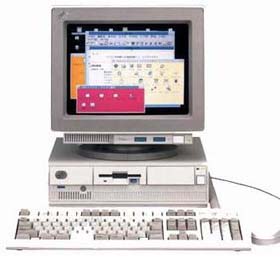5551-N/Y, general
| 51-N( and Y ) is SCSI model and
it's an IML SYStem. Reference and Diagnostic images are stored in the system partition in a hard drive which
is set to ID #6.
51-N/Y features
-
Synchro Streaming DATA Transfer
-
ECC memory ( not true ECC )
-
Onboard SPOCK SCSI ( with 512KB cache )
-
4 mode 3.5" floppy drive.
|
5551-N Specification
| Model |
5551
|
|
N0A
|
NAB
|
NAE
|
NXB
|
| Processor |
i486DX2-66 ( 8K L1 Cache, Math Co-Pro )
|
| RAM |
4MB
|
16MB ( ECC, 8MB x2 )
|
8MB ( ECC, 4MB x2 )
|
Disk
Drives |
FDD |
3.5" x1 ( 2.88MB/1.44MB/720KB )
|
| HDD |
100MB
|
200MB
|
540MB
|
200MB
|
| Option Slot ( for User ) |
32bit full size x2 ( 1 slot is already occupied with a display
adapter ) , 32bit half x 2
|
| Interface |
K/B port , Mouse port, RS232C x2 ( 9pin and
25pin ), CRT port, SCSI |
| SCSI |
Built in SCSI I/F on the planar, 512KB
caching SCSI ( SPOCK ! )
|
| Storage bay ( for user ) |
1
|
| Video Sub System |
PS/55 DBCS Display Adapter /J ( 1MB VRAM )
|
XGA-2 ( 1MB VRAM )
|
| Kanji Font ROM |
8,211 characters of JIS Level 1 and Level 2 and others. |
None
|
| Dimension/Weight |
360( W ) x 415 ( D ) x 103 ( H ) mm / 9.0Kg
|
|
|
| AC Input / PWR consump |
AC100--120V 50/60Hz / 138W MAX
|
| Pre-installed OS |
None
|
DOS J5.0
OS/2 J2.0 |
DOS J5.0
OS/2 J2.0 |
None
|
5551-NMB ( 16MB RAM, 200MB HD, XGA-2 ) was
equipped with OS2 J2.0 and MicroCADAM2 ( CAD software ).
5551-N System Board
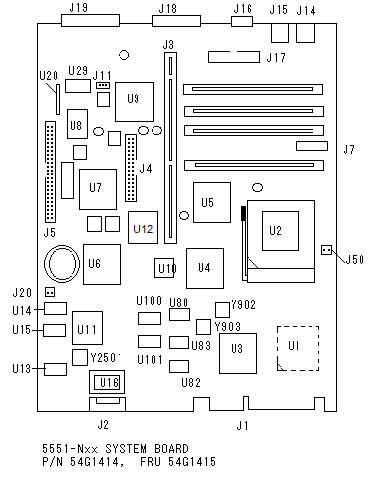 |
J1
Main Power
J2 Speaker Connector
J3 MCA Riser
Connector
J4 FDD Connector
J5 50 Pin SCSI
Connector
J7 Power connector
for optional Drives
J11 Overwrite power on pass
word
J14 K/B
J15 Mouse
J16 RS232C COM1
J17 RS232C COM2
J18 Printer
J19 60 Pin SCSI Connector
J20 Power for ?
J50 Power for CPU Fan
U1 Solder Pads for
486SX33
U2 ZIF Socket
U3 10G7808 (IBM 9314PQ)
U4 59G1883
U5 59G1885
U6 33F6715
U7 15F6903
U8 84F9324
U9 10G4672
U10 95F4195
U11 N80C188XL
U13 DALLAS DS1485S
U14 M5M5256BFP-12L
U15 10G4891
(M5M27C512AFP-12)
U16 BIOS one-time PROM
U80/83 74F543D |
Y902 OSC 66.666Mhz
Y903 OSC 66.666Mhz
Y250 OSC 32.000Mhz |
U20 37G2
465F1489
U100 SCSI
92F2246
U101 SCSI
92F2247 |
CPU
-N model;
DX2-66 is loaded on a ZIF socket.
Planar can take DX4ODPR-100,
am5x86
and
Cyrix5x86-GP100/120/133
on an appropriate interposer
with voltage regulator ( VRM socket is not prepared
on the planar).
-Y model;
I'm not sure whether a PGA 486SX-33 is on the socket or a QFP 486SX-33 is soldered on U1.
ODPDX2-66 is listed as CPU upgrade option for 51-Y.
Base clock is fixed to 33MHz ( both -N/Y ).
PODP can not be used on N/Y models. The socket itself can accept PODP but the BIOS doesn't
support PODP.
If a DX2-66 is changed to PODP, system will run, oh no, walk or crawl like a snail.
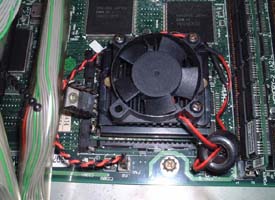 |
|
|
Click image to enlarge |
|
RAM
72 pin SIMM socket x4. Total RAM is limited to 32MB.
The planar takes FirstPage , True Parity, 70ns SIMM only
( Standard Industrial Parity SIMM) .
ECC/Parity selectable. You can select ECC mode in change-configuration
section in reference menu using true parity SIMMs.
If Ecc mode is selected, system performance relatively reduces comparing
to normal parity mode.
ECC function can be activated only when
total RAM size in bank A and bank B are equal.
eg 1; A1=8MB, A2=4MB, B1=8MB, B2=4MB
eg 2; A1=8MB, A2=none, B1=4MB, B2=4MB
No need to populate SIMMs in matched pair for A1/B1
and A2/B2.
Bu I recommend feeding 8MB sticks to all the SIMM
slots.
Expansion Slot
Total 5 slots are available in a small slim body using a short height
riser card.
On the riser card, there are 3 slots for full length adapters on the
left side( looking from the front panel )
and 2 slots for half length adapters on the right side.
1 slot( left bottom) is already occupied with a PS/55 Japanese Display
Adapter /J or XGA-2 /A according to model and type.
Riser card

This part is commonly used for
5551-W( 20Mhz) and 5551-R/L ( 33Mhz, EIDE ) models.
Video
No video chip is provided on the planar itself.
Two types of display adapters were available.
DBCS/Display Adapter-J
FRU 07G0446 For models except below.
XGA-2 /A 1MB
FRU 87F4744 For -NXB/NMB and -YXA
One of these adapters is loaded at slot # 6 ( left bottom facing to
the system from the front .)
4 Mode FDD: Star marked 2.88MB
4 mode drive x1.
The drive detects 2.88MB(2ED), 1.44MB(2HD), 740KB(2DD) and 1.2MB(2HD)
Japanese special mode.
Something about 1.2MB ( Japanese special
mode ) ; translated from 5551-N Quick Reference
In order to read and write 1.2MB formatted floppy, special device
drivers should be installed for DOS/V, JDOS
and OS/2 2.00 and higher environment. These drivers
are contained in a "Support Diskette for 1.2MB Diskette "
For DOS/V and JDOS;
Set the driver disk in A drive,
move to drive A, then type install c: following to DOS prompt.
Follow the installation instruction
appeared on the screen.
DOS device driver $FDD35IA.SYS
and format menu, FORMAT12.COM, will be installed.
IF you have only one FDD in your system,
drive letter D and E will be assigned as 1.2MB drive.
IF you have two FDDs in your system,
then drive letter D will be assigned to the 1st FDD and drive
letter E will be assigned to the 2nd
FDD as 1.2MB drive.
$FDD35IA.SYS is in Support Diskette Ver.
1.20 and 1.21.
$FDD35IA.SYS has been changed to $FDD12.SYS
in Ver. 2.01.
OS/2 2.00 and higher ;
Choose OS/2 full screen command prompt.
Set the driver disk in A drive, move
to drive A, then type install c: and press enter key.
OS/2 device driver and format utilities
will be loaded under \OS2 dir in targeted drive.
OS/2 drivers and utilities; OS2DASD.DMD,
IBM1FLPY.ADD, FORMATA.COM, DISKCOPY.COM
CONFIG.SYS will be automatically amended and following two lines
will be added.
BASEDEV=IBMFLPY.ADD
/PS2
REM --DrvInst--BASEDEV=IBM2FLPY.ADD
FORAMTA.COM under OS/2
Once these drivers are installed onto
your system, use FORMATA.COM instead of original
FORMAT.COM for formatting not only 1.2MB
but also for 2.88MB, 1.44MB and 720KB.
You can get detailed information in
HELP menu with typing FOAMATA without parameter.
Hard Drive interface (
Spock )
32 bit SCSI I/F is onboard. SCSI micro code set is
92F2246/47 and BUS master control code chip is 10G4891.
512KB cache is ready on the planar. One
50 pin SCSI Header ( not a card edge type ) is on the planar and one RS6000 style 60 pin connector is on the rear I/O
panel.
I couldn't configure F/W SCSI /A, AKA Corvette along with the
integrated SPOCK SCSI .
HDD
Depending on model-type, 200MB to 540MB SCSI hard drive was equipped.
IML drive should be set to ID=6 and the drive capacity is limited
<1GB.
IBM DPES1080 can't be used as an IML drive. Actual capacity of
the drive exceeds BIOS limit a bit.
Conner CFP1060 might be the biggest one which can be used as an IML
drive. ( Actually I used it on my N ).
I don't know why a HDD >1GB can't be used as ID=6 though it has
46/47 micro code combo.
If you can't find appropriate drive with 1G capacity, I recommend
to use a small drive for IML and choose
larger drive, say 2G or something, and give ID=5 to such a drive and set
it to "C drive" in set-configuration
( I mean "changing boot order " ).
Hard Drive bay
Two for 3.5" drives ( The bay beside FDD is already populated
with a stock SCSI HD and an optional drive bay locates below FDD ).
CD-ROM DRIVE
Unable to install a regular CDD within the case because a full length
5" drive will hit the PSU.
If you can get a drive for laptop models with SCSI interface and an
appropriate connector, and if you don't care for cosmetic appearance, maybe you can set it in the case. Rear I/O
panel
paralle x 1, serials( 25 pin and 9 pin ) x 2, mouse, keyboard,
1 RS6000 style SCSI connector.
Slot #1 is assigned for onboard SPOCK SCSI.
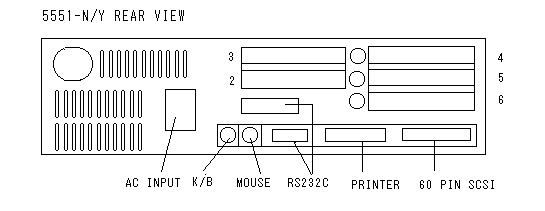
Ref & Diag
Ref ; Ver. 1.00/
1.01/1.11 are available. Ver. 1.11 is something
weird.
Diag ; Ver 1.00 for
the ref 1.00/1.01. Diag Ver. 1.11 is
for REF Ver 1.11
Body Design
Basic design for this machine was established in the model 5551-Wxx
which has 486SX-20. Drive structures used in 50-W were commonly
used for 51-N/Y/R/L models. It is impossible to identify model/type at a glance. You need to check the label
at the left bottom of the front cover.
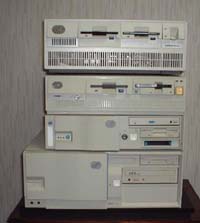 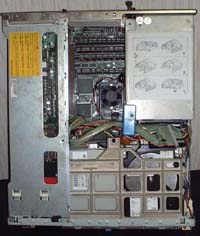 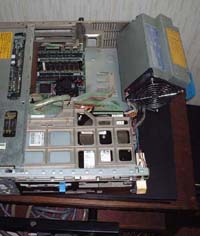
Pic #1
Pic #2
Pic #3
Click each image to enlarge
Pic #1 From top to bottom, 8570-A21,
5551-NAB, PC720 6860 with 2nd PCMCIA slots, PC750 6886
Pic #2 5551-N inner view
Pic #3 PSU will swing out to right as
above.
Clock rodding
A stock 51-N does not accept any higher OSC other than 66MHz.
It will stop with 102 error code.
My 5551-NAB has a
modified BIOS ROM and it accepts 80Mhz OSC ( 84Mhz is its limit
).
With the modified BIOS ROM and amd5x86, it runs
like a champ in 160MHz inner clock without 102 error.
Information from Quick Reference
Back to Top
Model 5551-R/L
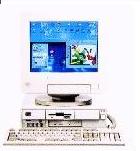 |
Appearance is completely same with 5551-N/Y
except rear I/O panel.
Main difference between 51-N/Y and 51-R/L is that 51-N/Y have
onboard SCSI I/F and IML function while 51-R/L have E-IDE
I/F and *NO* IML function ( reference partition is not used for 51-R/L.
"Set Configuration" should always be done with the reference
diskette).
-
Synchro Streaming DATA Transfer
-
ECC memory ( not true ECC )
-
IDE HD interface
-
4 mode 3.5" floppy drive.
|
5551-R/L Specification
| Model |
5551
|
|
R1D
|
RXD
|
RXE
|
RED
|
| Processor |
Standard |
i486DX2-66 ( 8K L1 Cache, Math-Copro )
|
| Option |
R model ; Pentium OverDrive Processor ( PODP5V83, P24T
so called )
L model ; 486-33/66 Double-clock processor option
|
| RAM |
4MB
|
8MB ( 4MB x2 )
|
16MB ( 8MB x2 )
|
Disk
Drives |
FDD |
3.5" x1 ( 2.88MB/1.44MB/720KB )
|
| HDD |
340MB ( IDE )
|
540MB ( SCSI )
|
340MB ( IDE )
|
| Option Slot ( for User ) |
32bit full size x2 ( 1 slot is already occupied with a display
adapter ) , 32bit half x 2 *1
|
| Interface |
K/B port , Mouse port, RS232C x2 ( 9pin and 25pin ),
CRT port
|
| SCSI |
None
|
SCSI /A -II/A 32
|
SCSI /A -II/A 32
|
| Storage bay ( for user ) |
1
|
1
|
1
|
0 ( Used for CD-ROM ) |
| Video Sub System |
DBCS D/A /NI-J
|
XGA-2 ( 1MB VRAM )
|
| Kanji Font ROM |
8,211 characters |
None
|
| Dimension/Weight |
360( W ) x 415 ( D ) x 103 ( H ) mm / 9.0Kg
|
|
|
| AC In-put/PWR |
AC100--125V 50/60Hz / 110W MAX
|
| Pre-installed OS |
DOS J5.0
|
PC DOS J6.1/V |
none
|
PC DOS J6.1/V
|
5551-RMD ( 16MB RAM, 320MB IDE HD, XGA-2 )
was equipped with OS2 J2.1 and MCADAM/2 ( CAD software ).
*1 SCSI Adapter II/A32
( SPOCK SCSI with 512KB cache ) is equipped for RXE and RED.
RXE; SCSI HD is hooked to
the SCSI /A. Onboard IDE is left unused.
RED; 340MB IDE HD is connected
to onboard IDE interface and a SCSI CD-ROM is connected to SCSI/A.
SYSTEM BOARD ( R Planar )
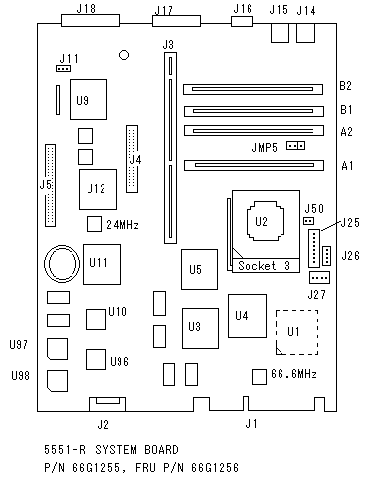 |
U1 : Solder
pads for 486DLC
U2 : ZIF Socket 3 ( Zif socket
1 for L planar )
U3 : 10G7808
U4 : 69G1261 SYS#1
U5 : 59G1885 SYS#2
U9 : 10G4672 I/O controller
U10: 95F4195
U96: 54G1412 FLASH G/A
U11: 52G7656 IDE G/A
U12: N82077SL
U97: 66G8422
U98: 66G8423
J1 : Power Connector
( not used )
J2 : Speaker
J3 : Bus Riser connector
J4 : FDD connector
J5 : HD connector
J11 : Overwrite power on pass word
J50 : No
jumpers present ( solder pads only )
JMP5 : Purpose
unkown ( see 5521-Y section )
J14 : KB
J15 : Mouse
J16 : COM1( 9pin)
J17 : COM2( 25pin)
J18 : Printer
J25 : Power In
J26 : Power In
J26 : Power for HD/FDD
U1 :Solder Pad for QFP( 486-BL2)
U2 : Socket 3 |
I/O PORT: 1 Parallel, 2 Serial ( 9 pins and 25pins),
mouse, keyboard .
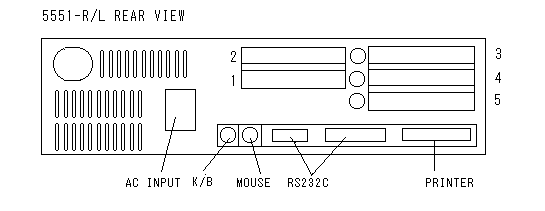
Video: depends on machine type,
two variations were available.
PS/55 DBCS Display Adapter/NI-J
FRU 54G1463 for models except below.
XGA-2 /A 1MB
FRU 87F4744 for -xXx and -xMx.
CPU and Socket type
R planar has solder pads for 486 QFP package, and
a 486DX2-66 is loaded on a ZIF socket 3.
L planar has a 486BL2-66 QFP package and has a ZIF Socket 1 just the
same place where a ZIF
socket 3 is placed on the R planar.
SIMM
Same as 51-N/Y . Support ECC function with true parity 70ns SIMMs.
PSU
Power Supply Unit is slightly different from that of 51-N in it's dimension,
but electrical specification is
almost same. PSU for 51-R/L is shorter than
that of 51-N/Y. R/L model has power connectors, J25 and J26, on the planar
and at the same time the planar has edge connector J1 at the front right
of the planar.
Both connectors are electrically connected. Both 5551-R/L
use AT-like power connectors on the planar.
Exception
L planar used in 5530-L
lacks J25/J26 connectors. There are solder pads on L planar used in 5530-L
.
5530-L uses edge connector
J1 to get DC from PSU.
Hard Disk interface ( EIDE,
a sort of... )
R and L models have EIDE interface on the planar. I once used
8.4G 16 heads drive in my 51-R and 30-L.
51-R /L was released before EIDE specification
was fixed. It could handle drive larger than 524MB.
I do not know it's upper limit. As far
as I can see, 51R recognized a seagate 8.4G 16 heads drive
which PC750 6886 could not recognize. ( The
very same drive once FDISKed using 51-R could be
used for 6886 but not as a primary *boot*
drive but as a secondary drive ).
Option
Short SCSI Adapter- II/32A with cache ( micro code 44/45 and yellow
DIP terminator ) is equipped in
5551-RXE/RED/RMD and 5551-LEC.
Genuine SCSI CD-ROM Drive, slim and short depth, is originally equipped
in RED/LEC.
CPU UPGRADE
5551-R is capable to run PODP5V83.
BIOS should be updated to use a PODP.
BIOS ROM is EEPROM( Flash ROM ) and only one revision ( for PODfying
) was released by IBM Japan.
I think am5x86-133 with a PowerLeap PL586
interposer is the best choice for upgrading R
model.
L planar can't take a PODP because it has ZIF Socket 1 which does not
fit to a POD( P24T ). AMD and/or
Cyrix on an interposer works fine.
Genuine Option for 5551-L
486-33/66 Double Clock Processor Option P/N 66G0727 was available.
Intel part JBOX DX2ODP66 could be used.
Reference and Diag diskette
Following Ref/Diag diskettes are commonly used for 5551-R/L and 5530-L.
Ref ; Ver. 1.21
Diag; Ver. 1.21
In order to use a PODP in 51-R,
Flash up program 5551FUP.EXE is required.
This exe file will create
1) Flash update diskette Ver. 1.30,
2) Diagnostic diskette Ver. 1.24
Clock rodding for 5551-R/L
70MHz OSC could be used instead of 66.666MHz OSC. Any OSC higher
than 70MHz will cause 102 error.
Win9x and 51-R/L
1. Unable to use genuine SCSI /A together with onboard EIDE interface.
To use genuine SCSI /A, do not use any IDE devices
off from the connector on the planar.
2. If you need to use SCSI devices together with IDE devices,
then choose Future Domain
MCS700, Adaptec AHA-1640 and BusLogic cards.
These cards can be used with it's IRQ other than 14.
3. IF you use Win98 on your 51-R/L with a genuine SCSI/A like
1. above ( no IDE drives ) but you have an
AMD am5x86 in it, then your 51R/L will
run in MS-DOS compatibility mode.
To solve this problem, replace AMD CPU to Cyrix
5x86.
This symptom commonly observed on 51-N and other
SCSI models using genuine IBM SCSI /A.
Back to Top
Windows98/98SE
Don Peter reported that he succeeded to run Win98SE on his IML
machine. But ( sorry Peter ) I can't
believe that any of IML machine could run Win98(SE) in
32bit disk access with built in SPOCK driver.
Anyway I don't use Win98/98SE on my PS/55's . Win98
is too "heavy" for my good old PS/55's.
Additional information ( 2002
01.06 )
Tested Win98 first edition English version on my
9585 xNx. 9585 run in MS DOS compatibility
mode
with a DX4-100 and an
am5x86-133 ADZ, but with a Cyrix 5x86-100
it run in full featured mode.
Am
I correct?
During
the test I also noticed that 9577 Bermuda ( with onboard SPOCK ) couldn't
take a Cyrix5x86 ( this
is not OS matter, but
the system wouldn't boot with Cyrix ).
| Updated 2002.10.13
Peter Wendt replied to the News Group about
incompatibility of Windows 98.
Peter said;
" it appears to be a bug in W98 IOSUBSYS
that fails to properly assign system resources on MCA
machines."
and "hebrew and
cyrillic versions of Win98 seem to be not affected."
Click
for full original text.
Folks, Do not doubt what Peter sez.
Don Peter has experienced all about MCA.
|
Back to Top
5521-Yxx
This model is almost same with 5551-R. CPU is degraded to i486SX-33.
The most distinctive feature of 5521 is that a Cirrus GD5428
1MB
SVGA /A was given for YSB
and YWB models instead of PS/55 Japanese Display Adapter.
5521 Specification
-
i486SX-33MHz CPU
-
3 mode 3.5" FDD ( 1.44MB/1.2MB/720KB )
-
DBCS DA /NI-J for Y1B and Cirrus SVGA for YSB and YWB
-
Support Synchro Streaming Data Transfer
Modified R/L
planar is used for this model ( QFP IBM486DL2-66
is omitted from U1 ) .
486SX33 sits on a Socket-1 at
U2.
This planar has a jumper block
at the location of J6 on R /L planar.
According to quick reference
the jumper should be turned on
when a double-clock processor option is used instead of a stock
486SX33 CPU.
Double-clock processor option
( P/N 66G0727 ) is commonly used for 5551-L, 5551-Y and 5530-L .
There are no such jumpers on these
system board ( At least both 51-L and 30-L has soldered
QFP
486 CPUs.
Cirrus
GD5428 SVGA /A ( adapter ID : 917A )

Cirrus GD5428 SVGA /A ( 1MB VRAM standard
but upgradable to 2MB) was not available as an
"optional part". It's different from
Cirrus SVGA used in Server 500 and is free from "flicker disease".
There are solder pads for additional VRAM
and the circuit is ready for adding SOJ VRAM's.
Win95 built-in driver can use full 2MB but
NT4 detects only 1MB.
Click here
for more information about Cirrus SVGA
Back to Top
PS/55 Index
|
